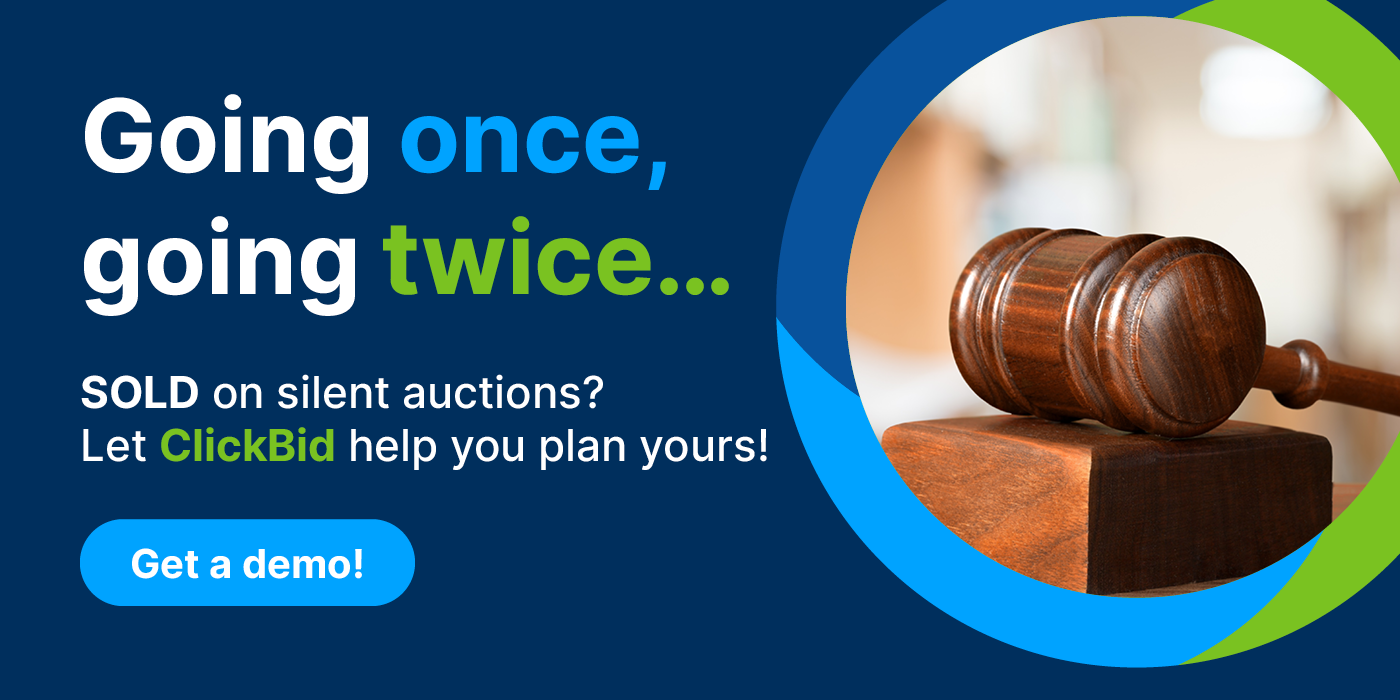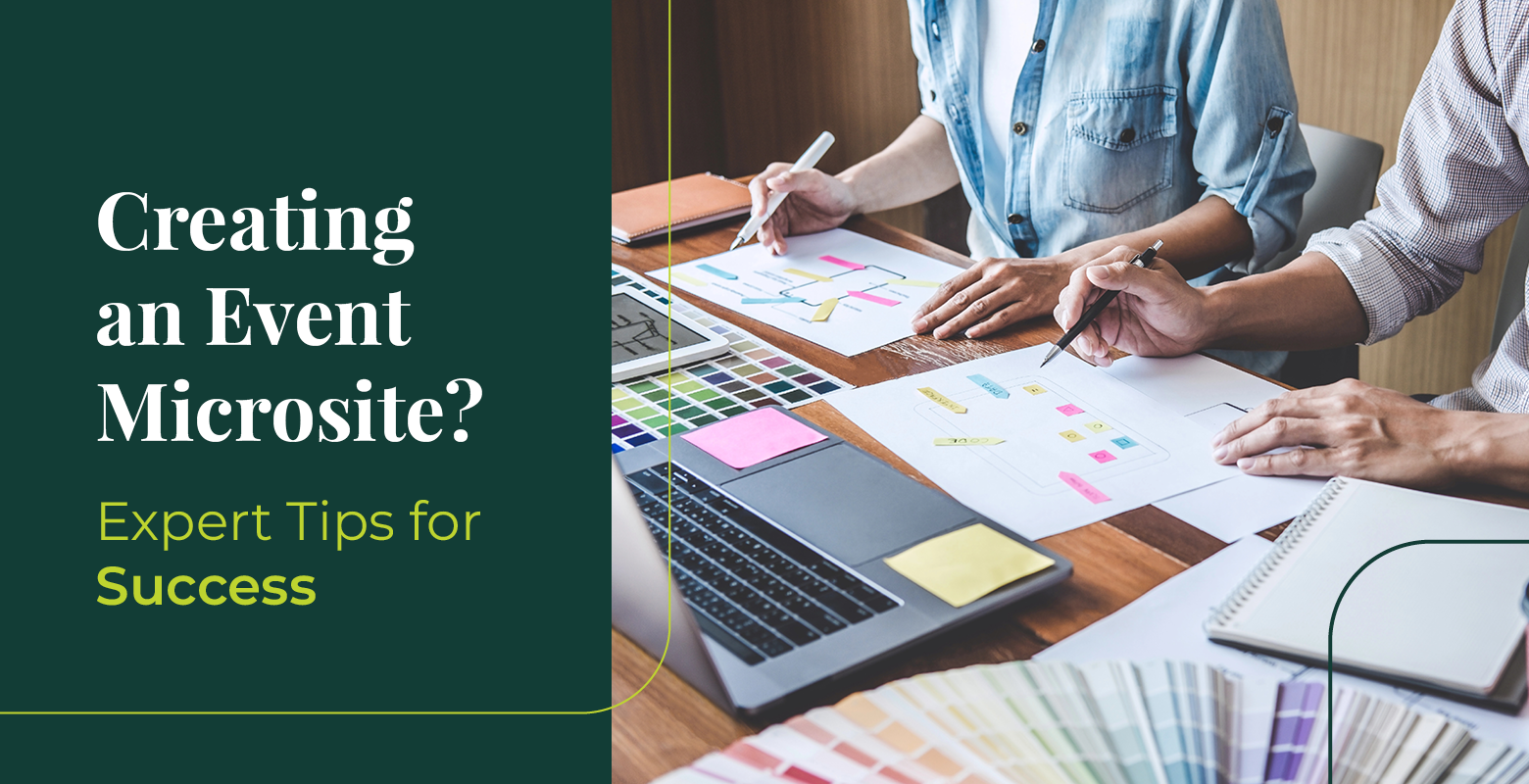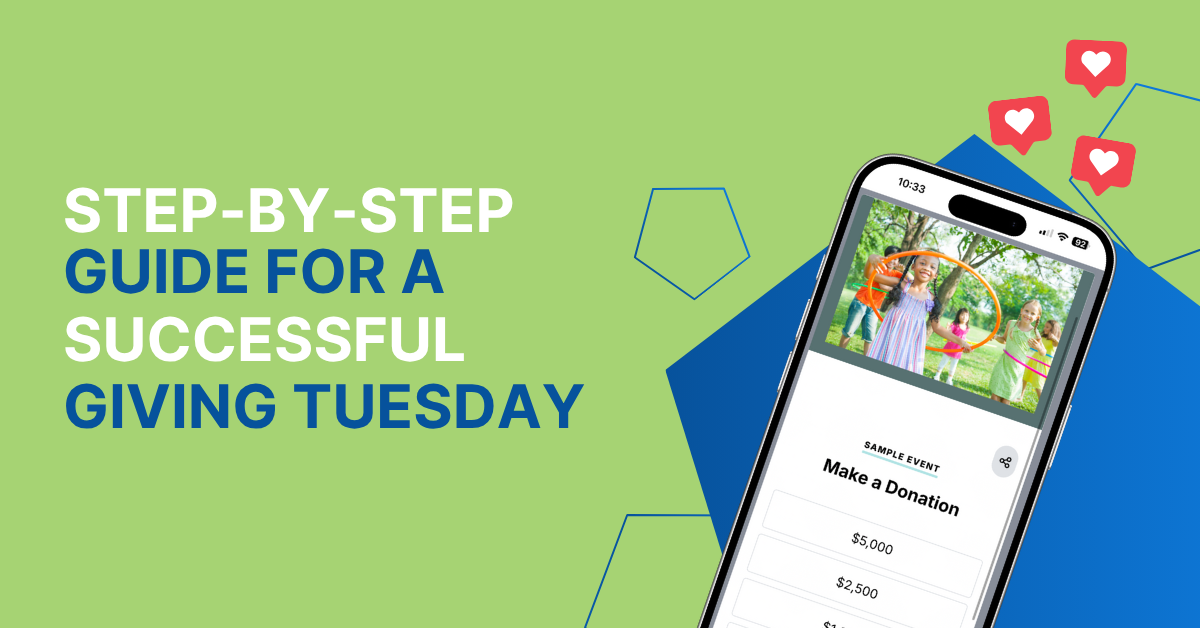
How to Plan A Silent Auction: Ultimate Guide with 10 Steps
December 18, 2023With 81% of U.S. donors attending nonprofit fundraising events, your organization needs to leverage event-style fundraisers now more than ever. As a nonprofit leader, you know that auctions are among the most engaging fundraisers, and their various formats make them flexible events for your nonprofit’s fundraising needs.
However, from event marketing to item procurement, these events can be complex fundraising ventures. That’s where this guide comes in! We’ll cover everything you need to know to plan a successful silent auction, including:
- What is a silent auction?
- How do silent auctions work?
- How to plan a silent auction in 10 steps
- Best practices for silent auction planning
Silent auctions empower nonprofits to engage their donor communities, spread awareness of their missions, and ultimately raise more. Consider your current fundraising strategy and how a silent auction could enhance it as you read through the following topics.

What is a silent auction?
Imagine this: You offer someone $5 for a book at a garage sale. The owner tells you that someone else has offered $10 for the same book, and now you feel the sudden urge to up your offer and outbid them!
This is the experience at a silent auction. Whereas live auctions offer the classic experience of an auctioneer and a loud gavel, a silent format provides the thrill of secretive, yet competitive, bidding.
A silent auction is a fundraising event in which attendees browse and place bids on auction items at their leisure through paper bid sheets or bidding software. At the end of the bidding period, the highest bid wins the item and the proceeds go to your nonprofit.
How do silent auctions work?
In a traditional silent auction, you’ll display items at the event’s venue with enticing descriptions and predetermined starting bids. Auction attendees compete against each other by writing their bids on a paper bid sheet and continuing to check the item and ensure they maintain the highest bid.
Now, with tools like ClickBid’s auction management platform, nonprofits can host silent auctions in a hybrid format or completely online using mobile bidding features. Bidders can fully participate in the auction virtually, completing the following activities from their mobile devices:
- Browse item pictures and descriptions
- Place bids
- Submit payments
Because of the self-driven nature of bidding at a silent auction, you can often supplement these events with other fundraising activities, such as text-to-give campaigns or gala dinners. This means that these auctions aren’t just convenient for your donors—they also offer even more opportunities for your nonprofit to generate revenue for its mission!
How to plan a silent auction in 10 steps
Follow these ten steps to successfully plan a silent auction for your nonprofit.
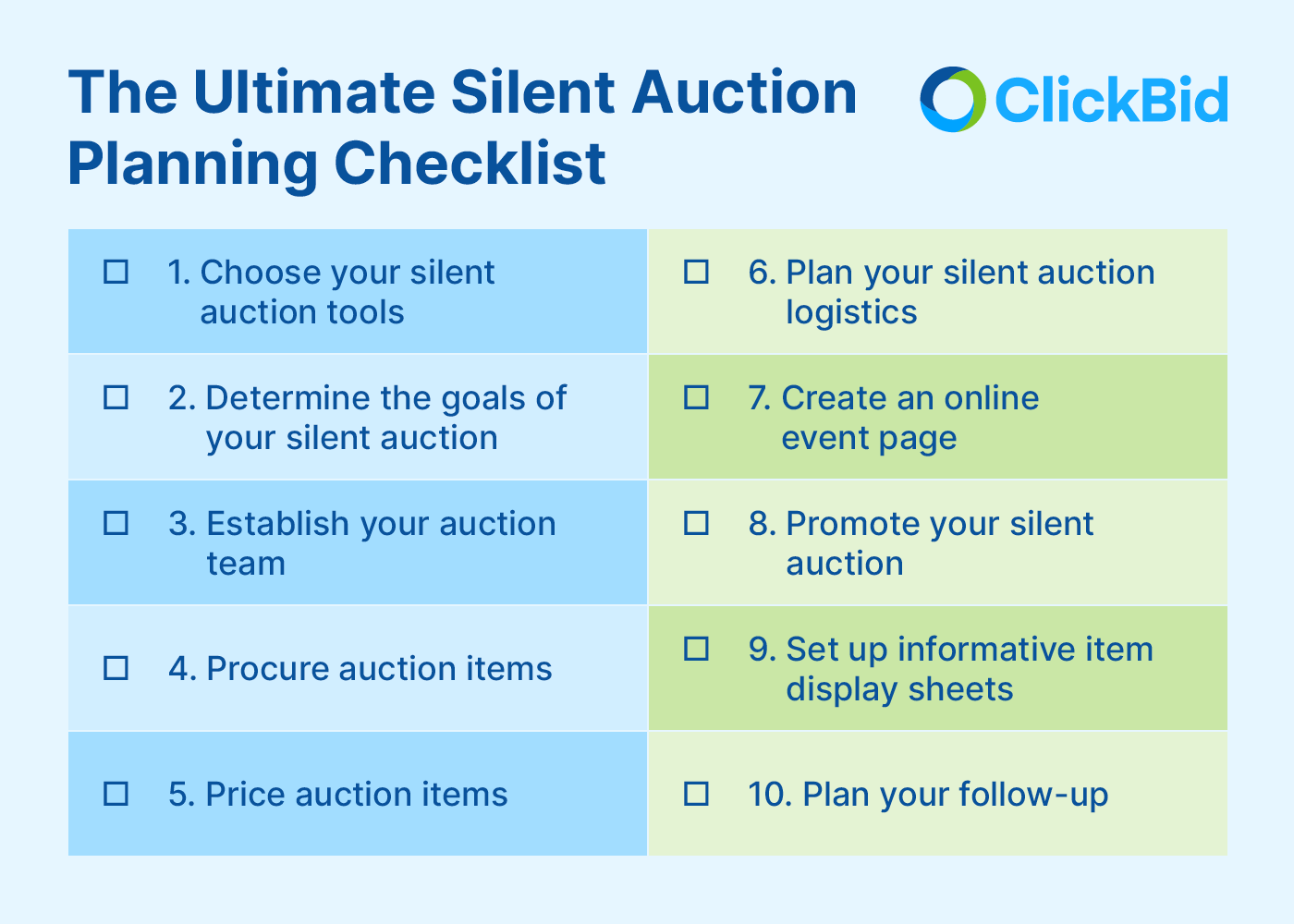
Step 1: Choose your silent auction tools.
Silent auction management software can streamline every step of your event planning process, which is why it should be your first consideration when you plan a silent auction! To find a solution that will work best for your nonprofit, look for the following features:
- Mass messaging: This feature allows auction leaders to send the right messages to the right people, like a team-wide message or a message to a select group of donors.
- Online auction catalogs: Catalogs not only display items to bidders but also help the procurement team organize their list of items as they collect them.
- Event landing page: Create an event landing page to develop an online presence for the event, as well as centralize information about the auction.
- Volunteer management tools: This feature oversees event tasks like check-in and check-out to help volunteers keep the auction running smoothly.
- Integrations: Integrations with popular CRMs can help with targeted outreach so your marketing team can use donor data to reach audiences with specific appeals.
An all-inclusive event fundraising platform, like ClickBid, provides all these tools and more, simplifying silent auction planning for your team. With ClickBid’s event fundraising platform, your silent auction will see increased engagement and an improved guest experience.
Step 2: Determine the goals of your silent auction.
Before you can host a successful auction, you must establish the milestones that mark event success. Equipped with these clear expectations, your team will be on the same page and have a solid understanding of the event’s progress. Some goals to consider include:
- Your goal revenue. What are you raising money for and how much money does your organization need? Set a reasonable and achievable goal for the revenue you expect your silent auction to generate.
- A planning process timeline. If you’re raising money for a specific project, you might already have a deadline in mind. If not, set one. Then, create a schedule for each planning task to determine when each part of the planning process should be completed.
- The event date. Set a reasonable event date according to what needs to be done and how quickly your team can finish it. You might also consider the timeline of your campaign goals when setting a date.
- The general number of attendees. Your guest list is a determining factor that will guide many of your planning decisions. Determine your target audience and estimate the expected size of your auction.
When setting your goals, review the timelines, sizes, and successes or failures of past fundraising events. Then, use these past insights to set reasonable goals. Approach your plans with an expectation of growth, but make sure your new goals are realistic for your team.
Step 3: Establish your auction team.
There are multiple elements to planning a silent auction, and delegating each of these tasks to a team or individual can help you organize the event planning process. Consider the following roles that you’ll need to fill:
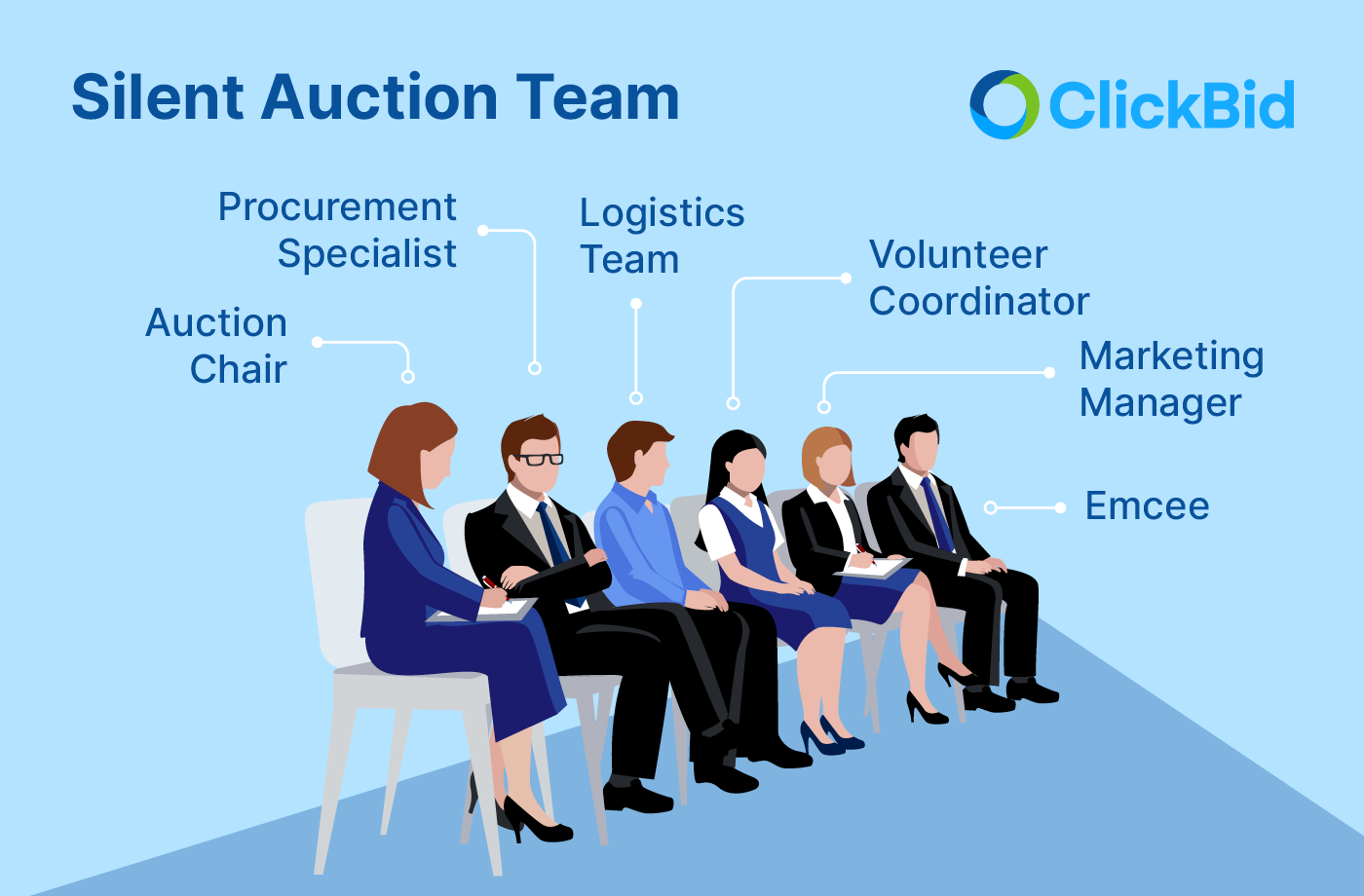
- Auction Chair: Establish the direct leader of the event, who will oversee everything from pre-planning to check out.
- Procurement Specialist: This person will be responsible for collecting auction items or overseeing a team that procures items.
- Logistics Team: Delegate event logistics and flow to this team, which will handle everything from the event flow to venue decoration.
- Volunteer Coordinator: The individual in this role will recruit and manage the event’s volunteer team, which may be responsible for various tasks like check-in during the silent auction.
- Marketing Manager: This person promotes your silent auction before, during, and after the event.
- Emcee: This speaker makes announcements at the silent auction, such as giving bidding instructions or announcing winning bidders.
Creating teams to focus on specific aspects of the event ensures each task gets individualized attention. This way, nothing is rushed through or forgotten. Plus, your staff will work together more efficiently when they each have a specific role that contributes to the event’s overall success.
Step 4: Procure auction items.
Most silent auction attendees are not major donors, so it’s important to plan your auction around various items and prices to encourage higher involvement from all guests. Find items that appeal to everyone to boost participation from all types of individuals in your audience. For example, you might procure the following items:
- Experiences: Offer the opportunity to engage in unique experiences, especially experiences relevant to your organization. For example, attendees might bid on the opportunity to tour your nonprofit’s facility.
- Travel: Auction off trip-related items, like plane tickets or hotel vouchers.
- Sports: Tickets to sporting events can be profitable items and are especially popular among sports fans.
- Food: Offer gift cards to local restaurants or taste-testing experiences.
Start your item procurement process early to give you and your team enough time to find the best items available. You should also create a wishlist of potential items you believe your donor base would be interested in. Then, send this list to your board members, major donors, corporate partners, and sponsors and encourage them to donate an item to your event.
Another helpful way to procure more items is by reaching out to local businesses. Encouraging them to donate to your fundraising event will create desirable and unique items that your donors will be interested in. If event supporters are unable to contribute specific items from your wishlist, you can also accept monetary donations to purchase items for your silent auction.
Step 5: Price auction items.
Properly pricing your silent auction items is essential to maximize revenue, but it can be a challenging task. Pricing your items too high can reduce bids and pricing them too low risks falling short of your auction fundraising goals.
To guide your item pricing, you should first establish the correct fair market value (FMV), or widely accepted monetary value, for each item. Accurate FMV estimations are crucial because any amount paid for an auction item over the FMV is tax-deductible. This means that when auction participants pay for an item, any amount more than that predetermined value will be tax-deductible, lowering their income tax expenses.Once you’ve established each item’s FMV, choose a starting price of around 30-45% of that value. This is the amount that bidding will start at, but the price will increase with each bid. The last person to place a bid uncontested by another bidder will win the item and purchase it for their final bid amount. In short, each item’s pricing should follow this model:
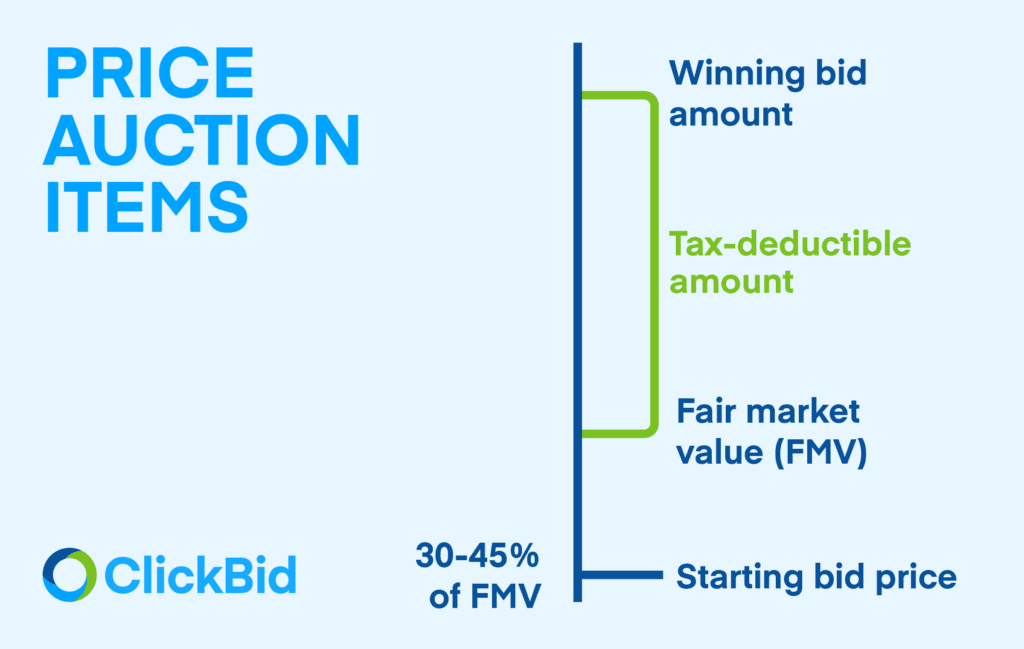
Depending on the FMV, you can round the starting price:
- FMV under $100: Round up to the nearest $5
- FMV up to $400: Round up to the nearest $10
- FMV up to $600: Round up to the nearest $25
- FMV up to $800: Round up to the nearest $50
- FMV over $1000: Round up to the nearest $100
Setting the correct bid increment also plays a significant role in the success of your silent auction. We recommend the following bid increments for the corresponding FMV:
- $50-149 FMV: $5 bid increments
- $150-249 FMV: $10 bid increments
- $250-399 FMV: $20 bid increments
- $400-599 FMV: $25 bid increments
- $600-999 FMV: $50 bid increments
- FMV over $1,000: $100 bid increments
Although price-setting may seem formulaic, be sure to evaluate your items’ prices with your unique auction in mind. Your bidders’ demographics and the popularity of the item can largely impact the way you present it at your auction.
Step 6: Plan your silent auction logistics.
Silent auction logistics are like the catch-all task of actually running the event. It will likely be an ongoing process with a variety of tasks, such as:
- Selecting an event venue
- Planning the event activities, such as raffles or entertainment
- Confirming the catering menu
- Finalizing the attendee list
- Determining the day-of activity schedule
- Assigning day-of tasks
Your event flow directly impacts your guests’ experience—having these details planned ahead of time will help the event go smoothly. Plus, a positive experience at this silent auction could encourage guests to attend future fundraising events, as well.
Step 7: Create an online event page.
In today’s world, an online registration page is the best move to easily share your event information with a large number of people. The software that manages your silent auction should have event page capabilities. Use this software to craft event pages that include:
- Event dates and information
- Ticket and sponsorship information and deadlines
- Additional features/upgrade options for purchase
- The complete registration process, where attendees will provide contact information, meal selection, seating preferences, and credit card information
- Dress code or party theme
- The highlights of your organization and your fundraising goal
- Contact information for any questions from registrants
Creating a clear, simple website with your event information will successfully engage your existing supporters and draw in new ones. For some, this event page will be their first interaction with your nonprofit, so creating an easy-to-use, yet attractive page will have a lasting impression.
Incorporating video on your event's registration page can inspire new viewers to become committed supporters and donate to support your mission. By implementing a hybrid event structure, you can allow your entire donor database to participate in your events through video, reaching a greater audience. ClickBid's EventStream feature allows you to stream video directly on the bidding site, allowing you to engage with out-of-town guests and create a memorable experience for those at home.
Step 8: Promote your silent auction
At this point, you’ve procured most of your items, created your event page, and finalized your event’s logistics. Now, it’s time to spread the word and build some excitement around your silent auction.
Generating attention and steering potential attendees to your event page is one of the most vital parts of your silent auction plan. After all, your event will only be successful if people actually attend!
When it comes to marketing any initiative, we’ve noticed many organizations maximize registrations and boost overall fundraiser revenue by employing multiple outlets for event promotion.
For silent auctions in particular, we recommend leveraging these channels:
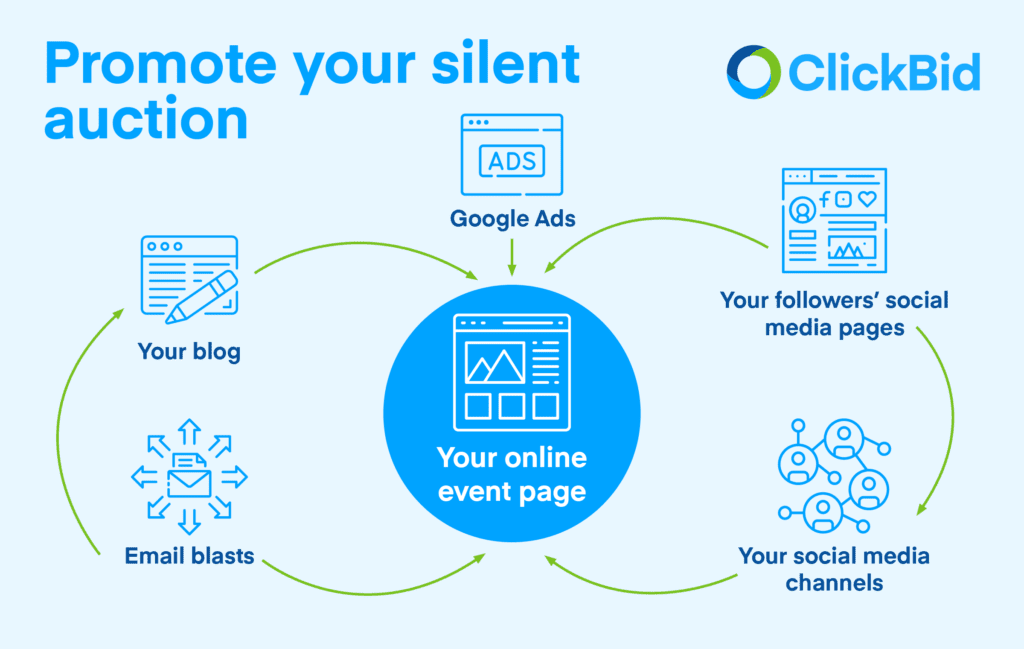
- Your online event page. Your website is the heart of your marketing efforts. Supporters visit it to stay in the loop on engagement opportunities, including events. Use your event page as a hub for all information about your auction. Include all the event’s important information here, then make sure each of your other communication channels points back to this main source of truth.
- Your blog. If your website includes an educational blog, write short posts that cover the basics of nonprofit auctions and encourage readers to check out your upcoming event.
- Email blasts. Use your weekly or monthly updates to remind supporters of your auction and encourage them to register. For example, you might send details about a current project that your nonprofit is working on, then present the auction as a solution to that fundraising need and explain how supporters can attend. Use attention-grabbing subject lines that persuade recipients to open your emails. Then, highlight key details about your event, including how to register and what items will be up for bidding.
- Google Ads. Even if you’re planning a silent auction on a limited budget, you can leverage paid advertising with the Google Ad Grant. Once you’re approved, use your free Google Ad credits to promote your event page on Google and drive registrations. You’ll need to craft compelling ads that persuade users to visit your auction’s landing page. Then, carefully choose keywords to place your ads in front of likely attendees.
- Social media. Platforms like Instagram and Facebook are a must for promoting your silent auction. On your organization’s page, announce the event and highlight big-ticket items to entice people to attend.
- Your followers’ social media pages. To bring supporters into your marketing efforts, encourage them to share your silent auction page with their social media networks.
No matter what platforms you choose, include a direct link to your event page across all marketing collateral. That way, users will know exactly how to participate once they feel inspired by your messages. In no time, registrations will start rolling in.
Step 9: Set up informative item display sheets
Silent auction display sheets are physical sheets that highlight relevant details about each item.
Even if your participants are bidding from their mobile devices, display sheets are important for your bidders to quickly read more information about your items without having to look up the item details from their mobile devices. To help guests familiarize themselves with mobile bidding, you can include printed information about how to bid around your auction items. This information will help guide your bidders and reduce confusion.
With ClickBid, you can easily generate item display cards with the information already uploaded and ready to print. Including QR codes for each item might be helpful for your bidders as well.
Step 10: Plan your silent auction follow-up.
You’ll need to follow up after your auction with prompt and genuine appreciation for everyone involved. Immediately thanking those who contributed to your silent auction shows donors, volunteers, and staff members that they made a big impact while the event is still fresh on their minds.
Double the Donation’s guide to donor recognition recommends the following strategies for acknowledging supporters’ gifts:
- Digital eCards: During the last phase of your silent auction planning, create themed eCards that are branded to your organization. Save drafts of various templates that you can pull from after the event. When the auction is finished, you’ll input donors’ names and specific information about their participation to make the eCard feel more personal.
- Branded gifts: Prepare t-shirts, blankets, hoodies, and other items branded to your nonprofit as thank-you gifts for silent auction participants. These can be placed in gift bags before the event and displayed on a table at the venue’s exit so that attendees can grab one on their way out.
- Notes from beneficiaries: Show donors the tangible impact of their participation in your auction by asking beneficiaries to write thank-you notes to each attendee. To streamline this process, ask beneficiaries to write general notes before the auction. You can supplement the note with a more personal introduction on behalf of your organization so that the message still feels personalized to the donor.
By preparing your follow-up during the silent auction planning process, you’ll be able to craft thoughtful appreciation efforts instead of sending out messages that feel like an afterthought. Just remember to leave room for personalization in whatever message or gift you send to each attendee.
Best practices for silent auction planning
While you may follow all the right steps to plan a silent auction, there are some additional best practices that can truly unlock auction success:
- Recruit a dream team. For those who are interested in helping with your silent auction, create applications that explain exactly what the job entails. You can even hold interviews with staff members or volunteers who apply to ensure you recruit a team of people who will drive success.
- Balance silent auction items. Aside from procuring items that appeal to everyone, choose items with values that match a variety of budgets. Some silent auction attendees will come for a great discount, while others are looking for high-value, luxurious items. Meet everyone’s needs with a well-balanced item catalog!
- Send enticing invitations. For pre-event promotion, get creative with your outreach by crafting physical invitations to send in the mail! This replicates the feeling of being invited to a birthday party or wedding, making the invitation feel much more personal than a general advertisement across your communication channels.
If this is your first time planning a silent auction, don’t get overwhelmed! Following the steps in this guide and leveraging these additional best practices can help to ensure you don’t miss anything.
Plus, the best practice of all when you plan a silent auction is to learn from your mistakes. If you’ve hosted an auction before, analyze the event’s performance and adjust your approach as necessary.
Plan a silent auction today
As with any fundraising event, thorough planning plays a significant role in meeting your fundraising goals. When you plan a silent auction early and stay organized, you’ll guarantee that you make the most of your team’s hard work!
If you’re looking for more resources to aid your auction planning, check out the following guides:
- 6 Live Auction Games That Increase Profits: Looking to supplement your next auction with a game? Check out these fun activities to raise and engage more!
- 8 Post-Event Communications for Nonprofits to Send: Auction follow-up has to be more than prompt to engage event attendees. Check out these eight ideas for post-event communications to better engage your donors!
- A Better Way To Curate Your Live Auction Items: Attention-grabbing auction items can be hard to find. Learn the five essential steps to streamlining the auction item procurement process.
Get The Latest Updates
Subscribe To Our Monthly Newsletter
No spam, notifications only about new products, updates.
Become a subscriber
Subscribe to our blog and get the latest updates straight to your inbox.

